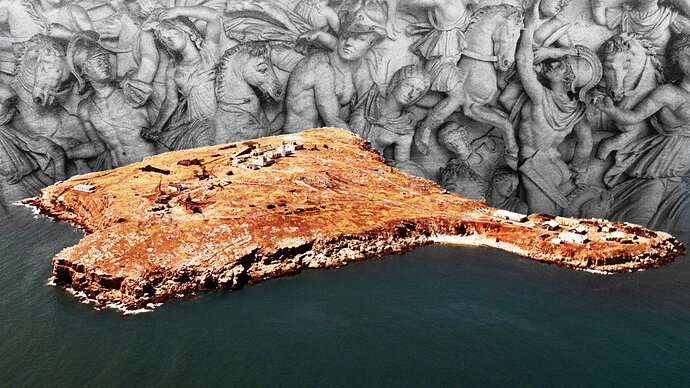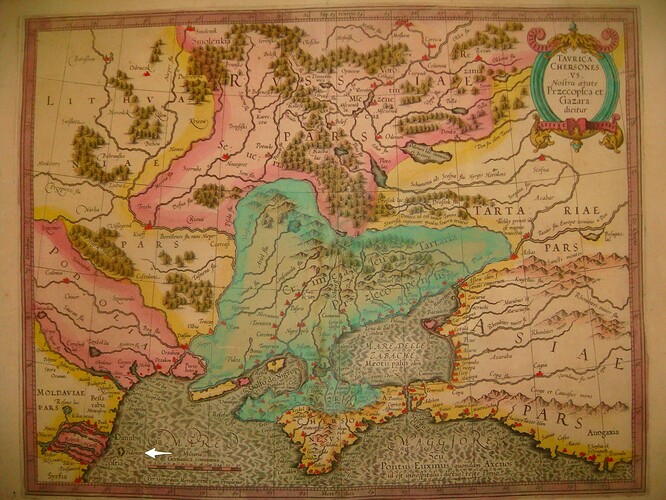Folks , now here's a fascinating story...I bet you hadn't heard this one before :))
Ukraine Island Is Where Achilles Supposedly Went Mad and Wiped Out the Amazons
LEGEND
Photo Illustration by Luis G. Rendon/The Daily Beast/Alamy/Getty
An island made famous by defiant Ukrainian border guards has a remarkable mythic past.
Candida Moss
](Candida Moss - The Daily Beast)
Updated Mar. 28, 2022 5:54AM ET / Published Mar. 28, 2022 3:22AM ET
Listen to article12 minutes
Almost exactly one month ago, a Russian warship issued a command to Ukrainian border guards stationed on Snake (Zmiinyi) Island in the Black Sea. According to reports, the invaders demanded that the soldiers “lay down arms and surrender to avoid bloodshed and unnecessary victims.”
The island’s defenders responded, “Go fuck yourself.”
The island was bombed, and the guards feared dead. President Volodymyr Zelensky awarded them the Hero of Ukraine medal. This week it emerged that at least some of the guards from Snake Island had escaped death and had been captured by Russian forces as a Ukrainian warship attempted to evacuate them.
Adrienne Mayor, the author of the forthcoming book Flying Snakes and Griffin Claws, told me that the island has a long history of divine protection from invaders. In his On Heroes, the second-century A.D. Athenian author Philostratus, tells the curious story of a group of shipwrecked sailors who were captured by ancient Amazons. In the story, a fleet of ships blown off course by a winter storm was wrecked on the coast of modern Georgia. The marooned soldiers were captured by ancient Scythian horsewomen (better known to us as Amazons) who tied them to troughs. The intention of the Amazons was to fatten the soldiers up for sale to local cannibals.
The sailors, as Mayor puts it in her book The Amazons, “were in luck.” One of the Amazon women fell in love with the youngest (and presumably least weathered) sailor and successfully pleaded with the queen to release the men. Mayor suggests that the young girl may have been Peisianassa (her name literally means “She Who Persuades the Queen.”), a woman who appears in some famous fifth-century B.C. artwork.
Now freed of their shackles, and possibly suffering from Stockholm syndrome, the men decide to stay with the Amazon women, enjoying the sexual freedom that life with the Amazons afforded them, and even learning their languages. In exchange they regaled their hosts with stories of the amazing things that they had seen on their travels. This is where things took a turn for the worse.
The most striking of their stories involved the Leuke (White) island—named for its white marble bedrock and (allegedly) white snakes and better known to us as Snake or Serpent Island—a desert island in the northern Black Sea. To the ancient Greeks, Snake Island was sacred to Achilles.
Why Achilles? You may ask. Well, it’s a little-known fact that, according to legend, Achilles was buried on Snake Island. The eighth- or seventh-century B.C. poem the Aethiopis relates that, after he received his fatal ankle injury at Troy, Achilles’ remains were transported to the White Island by his mother Thetis. As Mateusz Stróżyński writes for Antigone, later Latin authors Pliny the Elder and Arrian give the island the name the Island of Achilles. In antiquity the small island was said to be haunted by his ghost, which spent its time breeding a sacred herd of mares. As you do when you’re a ghost on an uninhabited island in the Black Sea.
When the Amazons, who are among history’s most famous horse-lovers, heard about Snake Island and its herd of mares, they decided to sail there. So, they commissioned their former captives turned lovers to build boats that could help transport the horses back from the island. While the ships were being constructed the sailors gave the dry-footed Amazons some instruction in sailing and rowing. When springtime arrived, they were ready to set sail.
After a long journey they arrived on Snake Island and began to cut down the trees in the forest that surrounded the sanctuary to Achilles. This violates rule number one of ancient sanctuaries: do not vandalize the sanctuary. This means no deforestation, no hunting of potentially sacred deer, no theft, and no sex within sanctuary precincts. Naturally, the now-angry spirit of Achilles enchanted the axes. Instead of cutting into the wood, they rebounded off the tree trunks and lopped off the heads of the would-be lumberjacks.
The Amazon women panicked and tried a last-ditch effort to round up the mares and herd them to the boats. They should have cut their losses. Achilles drove the mares wild. As Mayor puts it: “With pricked ears and bristling manes, the demonic horses trampled and bit the Amazons, tearing at their flesh and devouring the fallen bodies. The crazed herd of carnivorous mares, blood dripping from their teeth, stampeded to a high cliff and believing they saw a wide plain before them, hurled themselves into the sea.” A storm destroyed the Amazon fleet and an enormous wave washed away all trace of the Amazons, the sailors, and their ships.
All was right on the White Island again. Of course, as Mayor writes, this isn’t a strictly historical account. She writes, “Philostratus wove this fantastic horror story from threads of folklore, legend, myth, contemporary popular culture, authentic history, and pure imagination.” The story is also long on irony: the women known for their horsemanship are trampled to death by mares and having plotted to sell their sailors to be eaten they themselves get devoured by the horses.
But there are some snippets of truth amid the ancient horror story. Philostratus’ rough contemporary Arrian confirms that there was a temple dedicated to Achilles on the White Island, and that people who visited left gifts of rings, cups and precious stones. Inscriptions at the site in Greek and Latin refer to both Achilles and his beloved Patroclus. This suggests that it was here that Achilles and Patroclus finally got their happy ever after. For Arrian, however, the island’s cleanliness wasn’t down to phantasmic spring cleaning, but the birds that inhabited the place. Stróżyński relays that, according to Arrian, the birds would moisten their wings in the sea water each morning and then use their wings to sweep the floor of the temple. This still has a ring of Disney-style fantasy about it. Most of the story, including the horses, is impossible. As Christopher Stedman Parmenter wrote for the Society of Classical Studies: there’s no fresh water on the island, and there are no trees.
The ancient writer Dionysius of Alexandria notes that in addition to being called the White Island, Snake Island, and the Island of Achilles, the island was also known as the Island of Heroes. On that at least, Zelensky and the rest of us would agree.

Amazonka
Amazons of pre-Ukrainian Territories
7th to 5th centuries BC
Women warriors: First thought to be a myth
"What kinds of weapon did the Amazons have at their disposal? According to the ancient writers and iconographic evidence, the basic arms of the female fighters were bows and arrows, darts, spears, and also double battle-axes. Among the defensive weapons, the Greek authors mentioned shields in the form of a half-moon, battle-belts, and Hellenic bronze helmets (Miroshina 1995: 6).
"The Amazons were closely connected with horses. In the written records they are described not only as brave warriors, but at the same time as skilful equestrians. The great role of the horse in the life of the Amazons is demonstrated vividly by the names of three legendary Amazon queens: Lisippa, Hippo, and Hippolita (Johns-Blay 1997:70).
"The ancient myth was suddenly verified by the proof of rich female graves containing full sets of weapons and horse trappings. The extraordinary material honours that were paid to these deceased women are a clear indication of the deep respect for women in Sauromatian society, and perhaps even the belief among this tribe in the Mother Goddess (Mother Ancestor) cult. The Sauromatian females were not only brave warriors, they also held many religious and ritual functions. Only female burials contain portable stone altars and bone spoons adorned with the figures of beasts - evidently ritual objects. And, at the same time, very often we find in these graves a full set of weapons."
Click to retrieve articles:
Amazons in the Scythia: New Finds at the Middle Don, Southern Russia Author(s): Valeri I. Guliaev Reviewed work(s): Source: World Archaeology, Vol. 35, No. 1, The Social Commemoration of Warfare (Jun.,2003), pp. 112-125 Published by: Taylor & Francis, Ltd. http://www.jstor.org/stable/3560215.
Submitted by Jarko Sichynsky, 2012
"Rolle had discovered the graves of women buried with bows and arrows, swords and armour in the steppes of present-day Ukraine.
"The theory was the patriarchal Greeks had invented these women to show the infiinite superiority of males: okay, so women could ride, fight and kill, but they could never win. They were depicted as skimpy, smooth-cheeked creatures wearing trouses and pointy hats.
"They threw off their chains, slaughtered their Greek captors and took control of the ship. Unskilled in navigation, they drifted for days before reaching shore on the sea of Azov in what is now Ukraine."
"The Amazons were skilled riders and used defensive weapons."
Lyn Webster Wilde, author of On the Trail of Women Warriors, by Constable. Inquire on price through Book Offer, Geographical, 47c, Kensington Ct. London W8 5DA
The Amazons: Lives and Legends of Warrior Women across the Ancient World
ADRIENNE MAYOR
Copyright Date: 2014
Published by: Princeton University Press
Pages: 536
Stable URL: http://www.jstor.org/stable/j.ctt7zvndm
In Greek mythology, the Amazons were a tribe of women warriors. Apollonius Rhodius, at Argonautica, mentions that Amazons were the daughters of Ares and Harmonia. They were brutal and aggressive, and their main concern in life was war. Wikipedia
Archaeologists have found skeletons buried with bows and arrows and quivers and spears and horses. At first they assumed that anyone buried with weapons in that region must have been a male warrior. But with the advent of DNA testing and other bioarchaeological scientific analysis, they've found that about one-third of all Scythian women are buried with weapons and have war injuries just like the men. The women were also buried with knives and daggers and tools. So burial with masculine-seeming grave goods is no longer taken as an indicator of a male warrior. It's overwhelming proof that there were women answering to the description of the ancient Amazons.
When we say Amazons, we mean Scythian women. In this case Scythian warrior women. More: http://news.nationalgeographic.com/news/2014/10/141029-amazons-scythians-hunger-games-herodotus-ice-princess-tattoo-cannabis/
Regards




